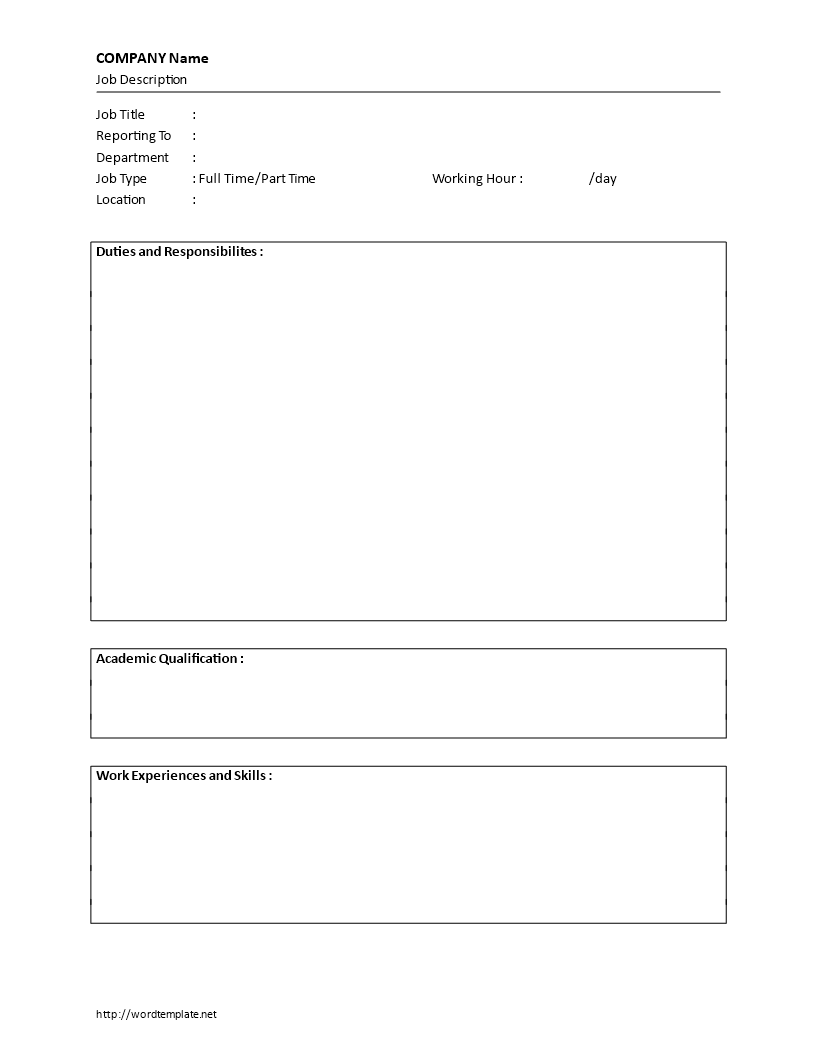Generic JD Sample Template For Internal Usage
Save, fill-In The Blanks, Print, Done!

Download Generic JD Sample Template For Internal Usage
Microsoft Word (.doc)Or select the format you want and we convert it for you for free:
- This Document Has Been Certified by a Professional
- 100% customizable
- This is a digital download (22.5 kB)
- Language: English
- We recommend downloading this file onto your computer.
What is the best way to make a generic job description template? How should a job description template be written? This template can be tailored to fit any job role and can be used to create an accurate job description for your hiring process. It outlines the responsibilities and skills required for the role and provides a clear overview of the job. Download this sample job description template now and fill it out!
A generic job description template is a pre-structured document that provides a standardized format for describing the key aspects of a job or position within an organization. It serves as a starting point for creating detailed job descriptions for various roles within a company. Generic templates are often used as a reference to ensure consistency in job postings and to save time when creating new job descriptions.
Creating a generic job description template involves structuring a document that can be easily customized for different positions within your organization. Here's a step-by-step guide on how to make a generic job description template:
Step 1: Choose a Format
- Decide on a format for your template. A typical job description includes sections for job title, department, responsibilities, qualifications, and other relevant details. You can create a template using word processing software like Microsoft Word or Google Docs, or use a spreadsheet program like Microsoft Excel or Google Sheets if you prefer a tabular format.
Step 2: Define the Standard Sections
- Identify the standard sections that will be part of every job description in your organization. Common sections include:
- Job Title
- Department or Division
- Reports To (Supervisor's Title or Name)
- Job Overview
- Key Responsibilities
- Qualifications
- Preferred Qualifications
- Working Conditions
- Salary and Benefits (optional)
- Application Process
- Equal Opportunity Employer Statement (optional)
Step 3: Set a Standard Layout
- Determine the layout and formatting you want to use consistently across all job descriptions. Define fonts, font sizes, headings, and other formatting elements. Consistency in layout and styling will help maintain a professional appearance in your job descriptions.
Step 4: Create Placeholder Text
- Within each section, create placeholder text or headings that will guide users to fill in specific details. For example:
- Job Title: [Job Title]
- Department: [Department or Division]
- Reports To: [Supervisor's Title or Name]
- Job Overview: [Provide a brief summary of the role and its purpose within the organization. Describe the primary objectives of the position.]
- Key Responsibilities:
- [List the primary duties and responsibilities associated with the role. Use bullet points for clarity.]
- Qualifications:
- [Outline the qualifications and requirements for the position. This may include educational background, experience, skills, certifications, and other relevant qualifications.]
Step 5: Include Guidance and Examples
- Consider adding guidance or examples in the template to help users understand what information to include in each section. For instance:
- Under the "Job Overview" section, provide a sentence or two as an example of how to summarize the role.
- In the "Key Responsibilities" section, provide examples of typical responsibilities for various types of positions in your organization.
Step 6: Designate Optional Sections
- If there are sections that may or may not apply to every job description, such as "Salary and Benefits" or "Equal Opportunity Employer Statement," designate them as optional and provide space for users to include this information if necessary.
Step 7: Review and Test
- Review your template for accuracy, clarity, and completeness. Ensure that it is user-friendly and easy for HR personnel or hiring managers to customize. Test the template by creating a sample job description to make sure it works effectively.
Step 8: Distribute and Train
- Once your generic job description template is ready, distribute it to the appropriate personnel within your organization, such as HR staff or hiring managers. Provide training or guidance on how to use the template effectively and ensure consistency in job descriptions.
By following these steps, you can create a useful and standardized generic job description template that simplifies the process of creating job descriptions for various positions in your organization.
Download this professional business template now! Using our business templates guarantees you will save time, cost, and effort and helps you to reach the next level of success in your education, work and business!
DISCLAIMER
Nothing on this site shall be considered legal advice and no attorney-client relationship is established.
Leave a Reply. If you have any questions or remarks, feel free to post them below.
Related templates
Latest templates
Latest topics
- GDPR Compliance Templates
What do you need to become GDPR compliant? Are you looking for useful GDPR document templates to make you compliant? All these compliance documents will be available to download instantly... - Google Docs Templates
How to create documents in Google Docs? We provide Google Docs compatible template and these are the reasons why it's useful to work with Google Docs... - IT Security Standards Kit
What are IT Security Standards? Check out our collection of this newly updated IT Security Kit Standard templates, including policies, controls, processes, checklists, procedures and other documents. - Letter Format
How to format a letter? Here is a brief overview of common letter formats and templates in USA and UK and get inspirited immediately! - Google Sheets Templates
How to work with Google Sheets templates? Where to download useful Google Sheets templates? Check out our samples here.
cheese

